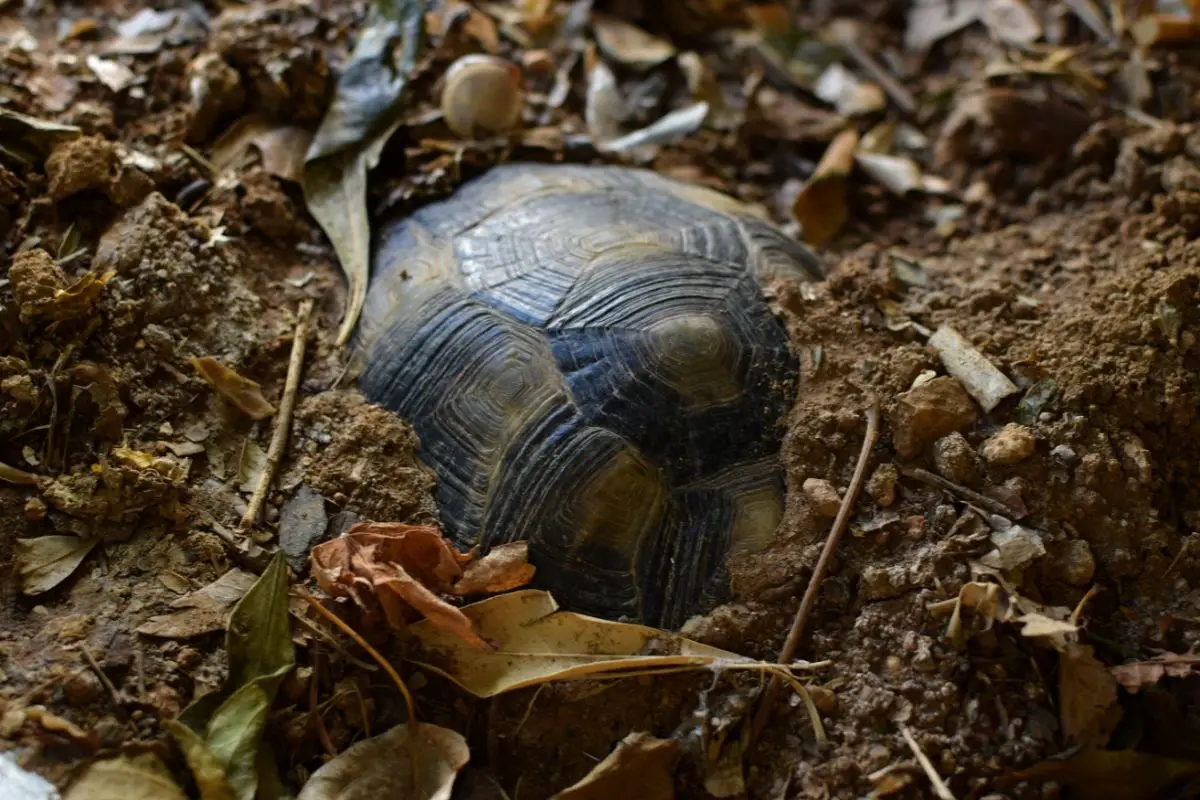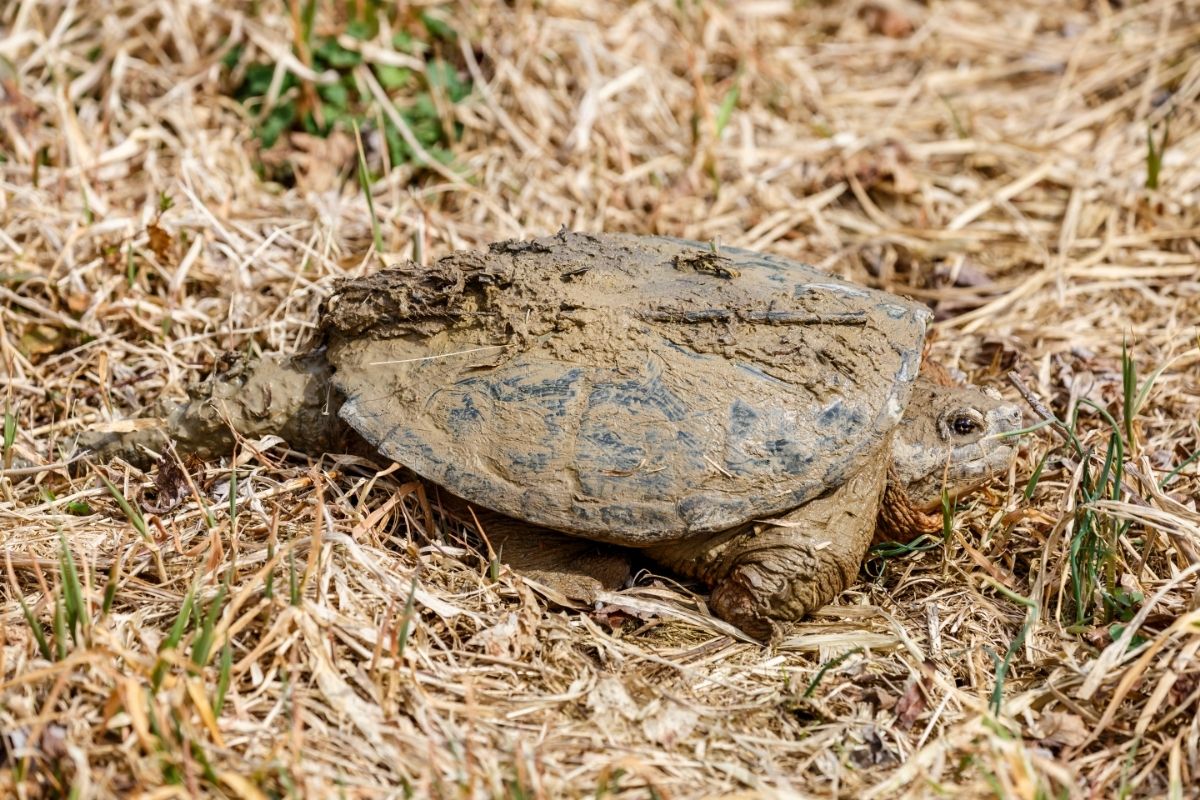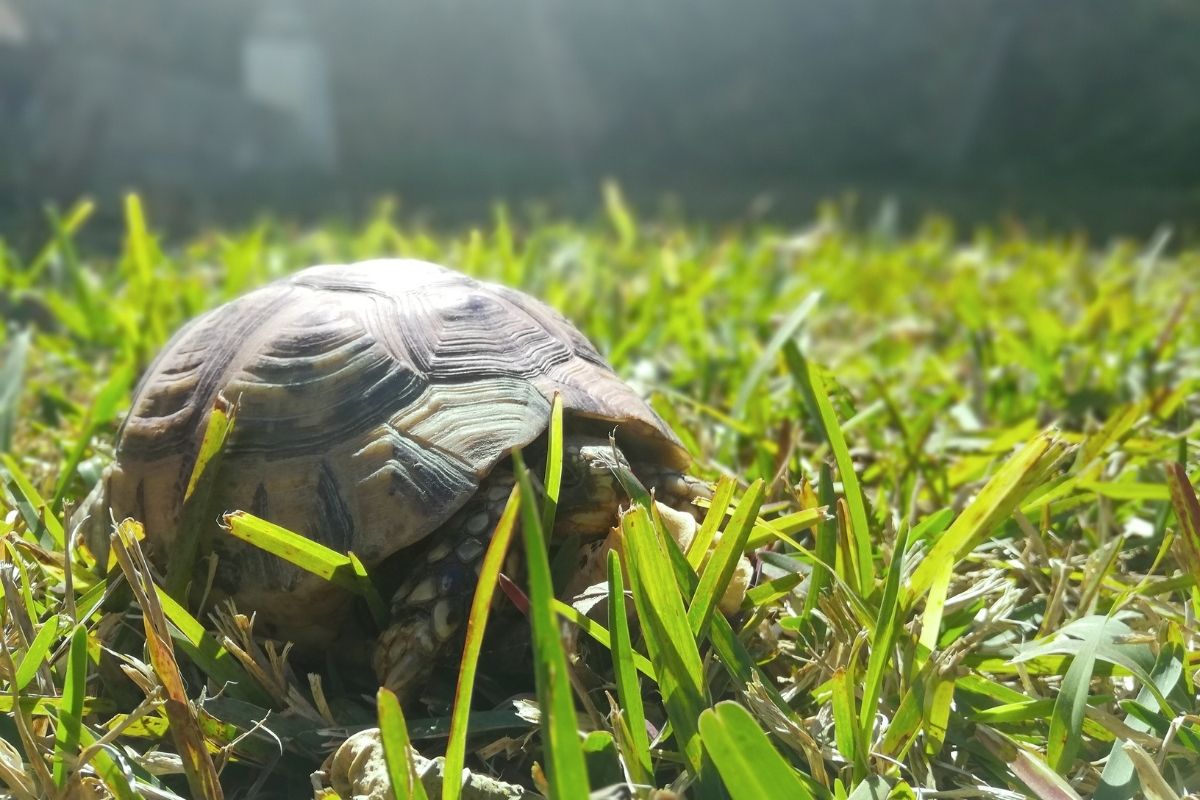Brumation and hibernation both refer to a period of time when various mammals and reptiles are dormant during the cold winter months.
Warm-blooded mammals hibernate and some cold-blooded animals use brumation to stay inactive for months.
Typically people say “hibernation” when talking about this dormant period of dormancy, but turtles are usually still active during brumation, such as crawling out of their spots and basking in the sun.

Turtles are cold-blooded creatures that need to stay cool in order to survive. Although they’re most active during the summer months when temperatures are high. Their hearts beat around 40 times per minute during this time.
During the colder winter months, they sleep more often. When they do wake up, they’ll be resting or sleeping near a source of heat.
Turtles can stay alive for long periods of time at near-freezing temperatures. Their metabolic rates are lowered by cold weather, thus preventing the buildup of lactic acids in their bodies.
Land Turtle Hibernation
Land turtles are slow-moving reptiles that prefer to stay in the shade. They eat decaying plants and insects. They are usually found in yards and gardens.
Land turtles are the most common species kept as pets. These turtles also need cold temperatures to lower their metabolism.
Land turtles also need insulation and shelter to avoid being frozen. When they’re outdoors, they cover up their shells with leaves. They prefer to sleep underground.
If you keep turtles as pets they should be kept out of the cold weather. When winter comes, they should be brought into a warm environment inside. Hibernation boxes are used to help them stay warm during the winter months.
Turtles need a place to sleep during winter. For this reason, hibernation boxes can be made out of wood. They are placed together to create an insulated area. Insulation keeps them warm while they sleep.
Turtles may also use these boxes to eat. In order to allow them to do this, you must first remove the top lid of the box.
Then, you can put some kind of substrate into the bottom of the box. When they’re done eating, you can replace the lid back over the box.
Turtles need vitamin A to stay healthy. In order to get enough vitamin A, you should feed them leafy greens and carrots. Towards the end of summer, start giving them alfalfa. This helps them digest the food better while they sleep.
Turtles eat solid foods. Fast them for about 1-2 months before hibernation. Hydrate them during this time. Reduce temperatures gradually until they reach hibernation.
Water Turtles
Water turtles hibernate by burrowing underground. They can be found in ponds, streams, or lakes.
Painted turtles can be found in gardens, and they usually stay near the surface. They can be kept in aquariums, but they prefer damp soil. Sea turtles can be kept indoors, and they enjoy moist leaves.
Snapping Turtles
Snapping turtles usually reside near ponds and always hibernate during winter. They tend to burrow in the ground at the bottom and become inactive. When spring arrives, they come out of hibernation and start moving around again.
They are usually very sluggish because they haven’t been active for so long and they also have high levels of lactic acid in their blood due to lack of oxygen while they were hibernating.
Box Turtles
Unlike other turtles, box turtles are reptiles that live underground and hibernate on land.
They start getting ready for hibernation in the Autumn and sleep through the cold winter season by burrowing into the ground and coming out of hibernation in springtime.
Red-eared Sliders
Slider turtles can be found in many different places including ponds, lakes, rivers, swamps, marshes, streams, and even oceans. When it comes to hibernation or brumation, they can choose to stay in water or land.
In order to hibernate, they need to get as much rest as possible. During this time, they may stop eating and drinking. They also close off their breathing passages and ears. This helps them conserve energy.
Sliders go into hibernation during winter months when temperatures drop below freezing. Their bodies become dormant until spring arrives. During this time, they eat nothing but insects. Sliders sleep in burrows or under logs.
They do not need to drink water because they produce moisture by breathing out carbon dioxide gas. That is why they are called “slider” because they slide around when they move.
Painted Turtles
Painted turtles are active during the summer months, but they hibernate during the cold season in the wild.
Like the others, during the winter, they go into a state of dormancy. Their shells get dark brown or blackish-brown. When they come out of hibernation, they become more active again.
Pet painted turtles don’t go into hibernation because they are in stable temperature conditions as long as their body temperature doesn’t drop too low.
Hibernation Care
Turtles can hibernate in ponds, but they also need a place to dig into. Make sure there’s enough substrate at the bottom of the pond.
Clean out the refrigerator if you’re keeping your turtle indoors and check your turtle every few weeks for any signs of illness or infection, and take it to a vet if necessary.
When coming out of hibernation, turtles need to be soaked in warm water for 2 hours before being placed back into their hibernaculum.
Outdoor turtles might not always find a suitable spot to hibernate, and indoor ones should be brought indoors if there is any chance of them freezing.
Is He Dead?
Turtles mostly hibernate in the wild. They can survive without eating during the cold season, but they must eat every day.
In the house, they may stay in a dark place when temperatures get low so you could be forgiven if sometimes you think they may be dead.
To warm them up, move them to a warmer place. Allow them to gradually heat up over the next 24 hours until they feel better. If they still don’t respond, they’re probably dead and you should take the appropriate action.
During brumation, they go into a state of torpor (a form of hibernation) to conserve energy.
When you pick them up, if they’re awake, they’ll move around, but if they’re asleep, they won’t react. If you touch their feet, they might hiss, but if they’re awake, that could be an alarm call.
Stages Of Hibernation

Pre-hibernating
Turtles begin to slow down during the pre-hibernation phase. They eat less and conserve any energy they have left. During this time, they also eliminate what they’ve already ingested so that there won’t be any leftover food.
A turtle needs to fast for 2-6 weeks before hibernation. He should be weighed frequently and kept hydrated by bathing daily. Don’t let him eat anything until he passes waste and drinks lots of water.
Turtles are very sensitive creatures, and if you’re not careful, they could get sick. He should be kept in a room around 55 °F. He can eat once every two days, and if he doesn’t get fed within three weeks, he won’t make it.
Some turtles weigh about 1 pound each. Some are more than 20 pounds. A turtle weighing 10 pounds is considered an adult.
A turtle weighing less than 5 pounds is considered a baby. These ratios are based on the weight of the turtle. How do you weigh a turtle?
Weighing
There are two methods of measuring turtles. Both are based on the size of the shell. The first method is called the Jackson Ratio.
It is used for Spur Thighs and Herman’s Tortoises. The second method is called the McIntyre Ratio. It is used only for Horsefield Tortoises.
Remember, the figures produced from this ratio should only be taken as an estimate, and each method should be used with the right tortoise for that method.
Actual Hibernation
Turtles go into a kind of sleep during the winter. Most of them do not hibernate fully. Instead, they go into a state of dormancy. They stay at the bottom of the pond or lake, and they burrow there.
Turtles hibernate during the winter months by entering a state of suspended animation in which their metabolic rate drops dramatically. This allows them to conserve energy while conserving body heat.
End Of Hibernation
When they emerge from hibernation, they begin to eat and drink more frequently. They also become more active. How long should they hibernate?
If you hibernate them too early or too late, they’ll get sick. Also, you need to make sure that they’re eating enough because they can’t eat during hibernation.
If you hibernate them too soon, they might starve to death so timing is crucial with pet turtles. So, always check with your exotics vet before you hibernate your turtles.
Hibernation periods vary depending on the species. For example, tortoises need to be kept warm during hibernation. A tortoise needs to be kept at an average temperature of 7 degrees Celsius and should be kept in a dark place away from light.
A large container filled with dirt or sand is ideal. This container should be placed in an area with ample air circulation.
Creating The Hibernation Environment

Creating the right home environment for a turtle is important for their long term care and comfort. It needs to be created so that hibernation will be an easy transition but how do you achieve this?
Box
If keeping your turtle in a box, make sure to use moist moss, as this helps replicate the turtle’s natural environment and helps by keeping them comfortable.
You can also add crumpled paper to keep the air flowing inside the box. Newspaper prevents moisture from getting out of the box.
When the turtles hibernate you must check the temperature every week and make sure you cover the box completely with a plastic tarp.
Don’t let anything touch the box. You can use a heat lamp to warm up the box turtle. You could also place the box turtle in an old carpet piece to insulate it and prevent cold drafts.
Hibernaculum
A hibernaculum is a useful home and is used to protect turtles and tortoises from predators. It should be constructed out of strong materials such as plywood or plastic.
Turtles and tortoises should be able to move freely inside the hibernaculum without getting stuck.
Firstly, pick your insulation. This needs to be done before adding the smaller box to the larger box.
Insulation helps regulate your pet’s temperature and keeps them from dying or leaving hibernation too early. The best insulation is polystyrene or packing foam.
Outdoor Pens
If you choose to keep your turtle outside, outdoor pens should mimic natural habitats as closely as possible.
Most experts agree that spending some time outdoors is very important for box turtles kept in captivity, but there are a few things to consider before building an enclosure.
Turtles need a lot of room to move around. A minimum of 4 ft by 8 ft is recommended for a box turtle pen. Try to keep your box turtle pen at least 4 ft by 4 ft.
Turtles need sunlight to synthesize vitamin D so a bright spot where they get sunlight for some time of the day is ideal. However, they also require places of shade to protect them from heat.
Turtles prefer solid sides because they can’t see through them. They try hard to escape if they can’t see past the wall. Wood and concrete are both good materials for turtle enclosures. Wire fences aren’t a great choice as they tend to be too thin.
For hibernation time the turtles need to be kept in a dark, moist environment so you should include an area that can be adapted for the winter months.
Turtles also need hiding places to stay safe from predators. Hiding places should be made of wood, concrete, or other non-porous materials. Water dishes should be deep enough so turtles can submerge themselves fully.
Burrowing spots should be dug up and mixed with other materials to create a loose soil mixture that is easy for box turtles to dig in. This should be done in order to provide them with more comfortable living conditions.
Also, plant some non-toxic plants around the enclosure to give them something else to eat. It’s useful to bear in mind that turtles are super clever and they can use sticks, small logs, and rocks as tools to dig out holes to lay eggs in.
Cave
If you decide to create a cave for your turtle they need to be placed carefully inside a cave. Ensure that Rocks can’t fall on them or crush them.
Leaving enough room for them to move around inside the cave is important. Providing a small cave, if carefully constructed, offers a lot of protection.
Conclusion
Owning a turtle can be challenging but if you educate yourself regarding their care, and provide what they need, they will truly become one of the family.
